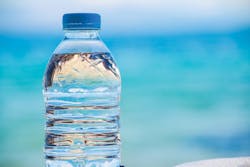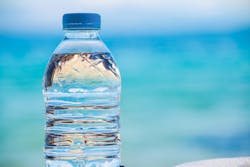Fluoridation remains the objective, whether bottled or tap
By Staci Violante, MSDH, RDH
Today, drinking bottled water is considered trendy and leads to potentially relinquishing tap water for drinking completely. Manufacturers produce high end ottled water to no-frills bottled water, bringing different price tags along with them. Bottled water may be more appealing than tap these days and is marketed to be clean and clear. However, most bottled water does not contain fluoride, which is essential to prevent tooth decay.
“Americans drink an average of 30 gallons of bottled water each year,” according to the CDC.1 Aside from saliva, water is necessary for lavation of the oral cavity. It may also prevent xerostomia or dry mouth, which can increase the acid production that leads to tooth decay. Although it may be the drink of choice and crucial to oral health, deficient of fluoride, it can actually aid in causing decay.
“It’s not the water that’s causing the decay,” said Jack Cottrell, DDS, president of the Canadian Dental Association (CDA) in MedPage Today. “It’s the lack of fluoride.”2 All water sources generally contain fluoride, but most do not have enough to cultivate adequate dental health.
Fluoride, an organic, unrefined mineral that naturally occurs in many foods, helps prevent tooth decay. It becomes immersed in the tooth enamel, particularly children’s teeth, and immediately after the teeth are fully developed, the fluoride increases the resistance to decay. The absence of fluoride in bottled water raises discussion of its role in the rise of decay in children. According to the American Dental Association, “If bottled water is your main source of drinking water, you could be missing the decay-prevention benefits of fluoride.”3
Most consumers do not drink tap water, which—in many areas—contains the proper supplemental fluoride we need to prevent tooth decay. However, not all bottled water is fluoride deficient. Due to many notable concerns, companies now offer fluoridated bottled water to encourage bottled water drinkers to drink more fluoridated water.
Regulating water
Water is regulated by organizations with distinct goals and objectives: “The US Environmental Protection Agency oversees the quality of water that comes out of the tap, while the US Food and Drug Administration is responsible for ensuring the safety and truthful labeling of bottled water sold nationally. States are responsible for regulating water that is both packaged and sold within its borders (which is most of the bottled water marketed), but one in five states do not bother to do so.”4
The FDA does not deem bottled water to be safer than tap water. In fact, it is quite the opposite in most cases. In most cities, before tap water is deemed safe, it must be disinfected, filtered of all pathogens, and tested for cryptosporidium parasites and giardia viruses. Although bottled water is also tested for bacteria and chemicals, tap or city water is tested much more frequently. For example, bottled water plants must test for coliform bacteria just once a week; city tap water needs to be tested 100 or more times per month.4
Bottled water may have an advantage in the testing for lead. Lead has the tendency to leak from pipes into tap water, especially in older homes. This is not the case in bottled water. Lead pipes are not used in the production of bottled water, so this does not pose an issue, but is indeed a major contention in the distribution of tap water.
As most dental professionals know, the advantages of fluoridated water are:
• Fluoride in tap water provides cavity protection, whether it’s consumed at home, school, or work.
• According to the ADA, studies show that “fluoride in community water systems prevents at least 25% of tooth decay in children and adults, even in an era with widespread availability of fluoride from other sources, such as fluoride toothpaste.”5
• It’s all natural.Fluoride is a natural, organic mineral that is present in most foods, dentifrices, and mouth rinses to protect against tooth decay.
• It saves money. The average cost per person to fluoridate the water supply is less than the fee of one dental filling. For most cities, every $1 invested in water fluoridation saves $38 in dental treatment costs.5
• Fluoride effectively helps control early signs of tooth decay and regenerate tooth structure.
What if fluoridated water is not enough? Obtaining fluoride through products and foods is another great way to incorporate it into your daily regimen:
• Consume many fruits and vegetables that contain fluoride.
• Use fluoridated dentifrices and professional fluoride varnishes or gels, which help protect and strengthen teeth against decay.
• Use fluoride supplements, such as prescription tablets or lozenges, which are designed for children who reside in communities without fluoridated water.
What patients should know
Adults who drink only bottled water may miss out on the valuable anticaries fluoride in tap water. Children miss not only the topical posteruptive benefits of fluoride but also the preeruptive developmental benefits from minimal fluoride exposure.5
On the other side of the spectrum, health-care providers should educate patients on acidosis caused by a high pH level found in bottled water. It is important for patients to contact the Environmental Working Group (EWG) to learn about their local water supplies. The EWG provides a database of quality analysis of 30 million state water records.6
The debate over bottled water and tap water continues. However, when it comes to oral health, fluoridated tap water is the obvious choice to obtain the fluoride needed to help strengthen teeth and protect against cavities. But despite the considerably beneficial factors fluoride provides, there are still concerns about tap water and its quality.
Bottled water is marketed as pure with the illustrations of crystal-clear waterfalls and pristine mountainsides. Consumers spend 10,000 times more per gallon for bottled water than they typically do for tap.7 As for the environment, although recycling has become the household norm, not everyone follows suit and plastic bottles are imposing on our landfills and landscape.
There are many factors to recognize. Fluoride aids in reducing acids and protects against demineralization, which occurs when bacteria and sugar couple in the mouth. Fluoride does not change the taste, smell, or appearance of water and is fundamental for overall dental health.
For those without access to fluoridated water or who are not getting enough daily fluoride, there are plenty of sources that contain fluoride, such as everyday food, beverages, and oral health-care products. An overexposure to fluoride can lead to fluorosis, which produces white stains on developing teeth.
Staci Violante, MSDH, RDH, graduated from the New York University College of Dentistry dental hygiene program in 1997. She went on to complete her master’s degree at the Fones School of Dental Hygiene at the University of Bridgeport. She has been a practicing clinical dental hygienist for the past 20 years serving as clinical professor in the dental hygiene department at New York University College of Dentistry. She is currently pursuing her doctorate of health science in education.
References
1. Community water fluoridation. Centers for Disease Control and Prevention website. https://www.cdc.gov/fluoridation/faqs/bottled_water.htm. Accessed June 25, 2018.
2. Postman A. The truth about tap. Natural Resources Defense Council website. https://www.nrdc.org/stories/truth-about-tap?gclid=Cj0KCQiAl8rQBRDrARIsAEW_To-koEbAagmexgA_rOVX7RrqmL22iW-K_2K5jQyk5qNjeowKBDwfGmIaApwxEALw_wcB. Published January 5, 2016. Accessed June 25, 2018.
3. The facts about bottled water. J Am Dent Assn. 2003;134(9):1287. http://jada.ada.org/article/S0002-8177(14)65095-9/fulltext. Published September 2003. Accessed June 25, 2018.
4. FDA regulates the safety of bottled water beverages including flavored water and nutrient-added water beverages. FDA website. https://www.fda.gov/Food/ResourcesForYou/Consumers/ucm046894.htm. Updated November 15, 2017. Accessed June 25, 2018.
5. 5 reasons why fluoride in water is good for communities. ADA website. http://www.ada.org/en/public-programs/advocating-for-the-public/fluoride-and-fluoridation/5-reasons-why-fluoride-in-water-is-good-for-communities. Accessed June 25, 2018.
6. Tap water database. Environmental Working Group website. https://www.ewg.org/tapwater/?gclid=Cj0KCQjwjN7YBRCOARIsAFCb934DA3pLInYYKXwqgs4iOyPDryyE5m7cBf63QqzsN9wv4IiwJGlDV8kaAndBEALw_wcB#.WxhgHy2ZOfc. Accessed June 25, 2018.
7. Olsen E. Bottled water: Pure drink or pure hype? https://www.nrdc.org/resources/bottled-water-pure-drink-or-pure-hype. Published April 30, 1999. Updated July 2013. Accessed June 25, 2018.
Bottled versus tap?
Bottled
The Natural Resources Defense Council (NRDC) performed a four-year review of bottled water and its safety standards. The review concluded that there is no assurance that bottled water is cleaner or safer than tap. In fact, an estimated 25% or more of bottled water is really just tap water in a bottle, sometimes further treated, sometimes not.2
In the same review, 1,000 bottles of water were tested and proven to be rather clean and clear. About 22% of the brands tested contained chemicals at levels above state health limits in at least one sample. If consumed over a long period of time, some of those contaminants could cause cancer or other health problems for people with weakened immune systems.2
Tap
Essentially, tap water is safe but nevertheless poses concerns for those who live in provincial communities with elevated pesticide overflow contamination, live in communities that obtain their water from an unregulated private well, or live in an older home.
Homeowners can test their own water to make sure it is safe. Standard test packages are available. However, the law states that tap suppliers must provide annual reports to all customers.

